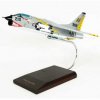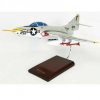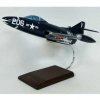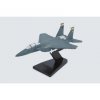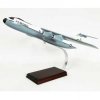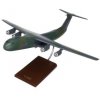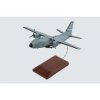"The F-5E Tiger II is a single-seat version for the Tunisian Air Force. In 1950, the F-5 started its life as a privately-funded light fighter program by Northrop. The first generation F-5A Freedom Fighter entered service in 1960. During the Cold War, there were over 800 produced through 1972 for US Allies. The F-5 proved to be a successful combat aircraft for US Allies, but it didn't entered front-line service with the US due to diverging priorities of the US services. A few surplus F-5As and F-5Es have been sold to private owners. In 1970, Northrop's F-5A-21, which subsequently became the F-5E, was designated to replace the F-5A. It was lengthened and enlarged, with increased wing area and more sophisticated avionics, and was initially having an Emerson AN/APQ-153 radar. The F-5E eventually acquired its official name Tiger II. In its service life, the F-5E experienced numerous upgrades. The F-5E Tiger II has a crew capacity of 1. It has a maximum speed of 917 kn and a ferry range of 2,010 nmi. The F-5E Tiger II production amounted to 1,400 including all versions and production ended in 1987. Various F-5 versions remain in service with many other nations. Singapore has approximately 49 modernized and re-designated F-5S and F-5T aircraft. The F-5 was also developed into a reconnaissance version, the RF-5 Tigereye."
Scale: 1/40 scale model
Wing Span: 8.25
Length: 14.5
CF005T2T
|
"The F-8 Crusader is a single-engine aircraft carrier-based fighter aircraft built by Chance-Vought and was a replacement for the Vought F-7 Cutlass. The first prototype of F-8 Crusader flew on March 25, 1995, manned by John Konrad. During its maiden flight, the F-8 exceeded the speed of sound. The F-8E was the last Crusader variant produced. The F-8E is an air superiority fighter version for the French Navy. There were 42 orders by the French Navy for use aboard new carriers Clemenceau and Foch. The F-8E has a crew of 1. It has a maximum speed of Mach 1.86 and a ferry range of 1,735 mi. It has four 20 mm Colt Mk 12 cannons in its lower fuselage and 125 rounds/gun. It has eight Zuni rockets in four twin pods. It has four AIM-9 Sidewinder air-to-air missiles and two AGM-12 Bullpup air-to-ground guided missiles. It has an increased wing lift and an added boundary layer control system and enlarged stabilators. The primary users and operators of the F-8s are the United States Navy, United States Marine Corps, French Navy and the Philippines."
Scale: 1/48 scale model
Wing Span: 9.88
Length: 14
CF008NT
|
"The F9F-8 Cougar, manufactured by Grumman, was designed to serve as an aircraft carrier-based fighter aircraft for the United States Navy. Based on the earlier Grumman F9F Panther, the Cougar replaced the Panther's straight wing with a more modern swept wing. The Navy considered the Cougar a mere new version of the Panther (despite adopting a different official name) and thus Cougars started off as F9F-6 and upwards. On January 18, 1954, the F9F-8 had its first flight. A total of 601 F9F-8s were delivered to the Navy between April 1954 and March 1957. During the course of production, a fixed in-flight refueling probe was added to the nose. Most F9F-8s were fitted with Ultra High Frequency (UHF) homing antenna in a fairing underneath the nose. Late production F9F-8s were fitted with the capability of carrying two Sidewinder infrared-homing air-to-air missiles underneath each wing. This feature was retrofitted to many earlier F9F-8s. In 1962, the F9F-8 was redesignated F-9J under the new Defense Department Tri-Service designation scheme. The F9F-8B fighter-bomber became AF-9J. Later, when used as advanced trainers, some of these aircraft became TAF-9J. "
Scale: 1/32 scale model
Wing Span: 13.65
Length: 17.63
CF009NCT
|
"The F9F Panther is a fighter-bomber aircraft manufactured by Grumman. It was widely used during the Korean War. The Panther have been notable for its prominent role in the 1954 movie Men of the FIghting Lady and was also featured in the flying sequences in the 1955 movie The Bridges at Toko-Ri. The prototype Panther first flew on November 24, 1947. F9F-5s, together with F9F-2s and F9F-5s have distinctively served in the Korean war, having downed two Yak-9s and five Mikoyan-Gurevich, with only one loss of F9F. In 1956, Panthers were withdrawn from front-line service, but remained as trainers and with Reserve units until 1958 and some continued to serve in small numbers into the 1960s. The only foreign Panther buyer was the Argentine Navy, having bought 24 ex-USN aircraft in 1958. The Argentine Panthers were involved in general mobilization during the 1965 border clash between Argentina and Chile, but there wasn't any combat that occurred. In 1969, Panthers were removed from active service due to lack spare parts and was replaced with A-4Q Skyhawks. The F9F-5 Panther is a variant of the F9F-5 but is powered by Pratt & Whitney J48 engine. There were 616 F9F-5s built. "
Scale: 1/32 scale model
Wing Span: 13.63
Length: 13.5
CF009NPT
|
"The Grumman F-14 Tomcat is a supersonic, twin engine, two-seat, variable sweep wing, two-place strike fighter manufactured by Grumman Aircraft Corporation. F-14 was the United States Navy's primary maritime air superiority fighter, fleet defense interceptor and tactical reconnaissance platform from 1974 to 2006. The F-14 first entered service in 1972 with the U.S. Navy, replacing the F-4 Phantom II. The F-14A variant is a a two-set all-weather interceptor fighter version for the US Navy and modifications late in its service life added precision strike munitions to its armament. There were 545 F-14A delivered to the US Navy and 79 to Iran. The final 102 F-14As were delivered with improved TF30-P-414A engines. An additional F-14A was manufactured for Iran, but was delivered to the US Navy. The Tomcat is capable of deploying air-to-ground ordnance in various configurations, while simultaneously carrying the AIM-7, AIM-9 and AIM-54 air-to-air missiles. The F-14 has an airspeed of Mach 2+ and it was scheduled to remain in service through at least 2008. On September 22, 2006, the F-14 retired from the U.S. Navy fleet and was replaced by the F/A-18E/F Super Hornet. As of 2007, it remains in service only with the Islamic Republic of Iran Air Force. "
Scale: 1/48 scale model
Wing Span: 16
Length: 16
CF014ST
|
"The F-14A Tomcat was the United States Navy's primary maritime air superiority fighter, fleet defense interceptor and tactical reconnaissance. The aircraft was originally designed as the successor of the F-4 Phantom in the fleet defense roll. The aircraft was designed to provide the Fleet with a Mach 2.0 (twice the speed of sound) air superiority fighter capable of fleet defense at both long and short range. The aircraft was the 59th built and the 57th to be delivered to the Navy on February 20, 1974. It first served with the VF-1 ""Wolfpack"" aboard the USS Enterprise from May 1974 through July 1976. During this time, the aircraft flew missions during a WestPac cruise under the code name Operation Frequent Wind, the evacuation of Saigon, South Vietnam. This makes the Tomcat a true Vietnam veteran. The F-14A Tomcat was transferred to the training squadron VF-124 ""Gunfighters"" in July of 1976 where it spent approximately 1 year. In June of 1977, it was transferred to VF-2 ""Bounty Hunters"", the sister squadron to VF-1 aboard the Enterprise again. While it was with the VF-2, this aircraft also flew off the USS Ranger and USS Kitty Hawk. The Tomcat's combat initiation occurred in a successful encounter with Libyan Air Force Sukhoi Fighters in August 1981. The F-14 has undergone considerable upgrading and modification during its life and has been continuously tested at Patuxent River since 1972. The mission expansion of this aircraft includes tactical air reconnaissance and delivery of laser guided air-to-ground weapons and it also ensures the Tomcat's value to the Fleet well into the 21st century. "
Scale: 1/72 scale model
Wing Span: 10
Length: 6.25
CF014TR
|
"The F-15E Strike Eagle is a dual-role fighter designed for long range interdiction of enemy ground targets deep behind enemy lines. An array of avionics and electronics systems gives the aircraft the capability to fly at low altitude, day or night, and in any weather condition. Derived from the F-15 Eagle, the Strike Eagle has proved its worth in various operations, carrying out deep strikes against high value targets and providing close air support for coalition troops. The F-15E can be distinguished from the F-15 by its darker camouflage and the conformal fuel tanks attached to the fuselage. In March 1981, the United States Air Force (USAF) announced the Enhanced Tactical Fighter program to procure a replacement for the F-111 Aardvark. General Dynamics and McDonnell Douglas submitted proposals, and in February 1984, the contract was awarded to McDonnell Douglas. The F-15E had its maiden flight on December 11, 1986. While designed for ground attack, the versatile Strike Eagle retains much of the air-to-air lethality of the F-15 and can defend itself against enemy aircraft. The F-15E saw combat during Operations Desert Shield and Desert Storm after Iraq invaded Kuwait in August 1990. On February 14, 1991, an F-15E scored an air-to-air kill, a Mil Mi-24 Hind helicopter. The attack was in response to a request for help by US Special Forces. Following Desert Storm, two no-fly zones were set up over Iraq and policed mainly by US and UK aircraft. The Strike Eagle would fly into combat on many occasions over the next decade and was the most highly-tasked of all USAF tactical fighters. The F-15E usually attacked ammunition bunkers, command and control facilities, towed anti-aircraft batteries and launchers. It also cooperated with other aircraft in strikes. "
Scale: 1/42 scale model
Wing Span: 12.25
Length: 18.25
CF015ETS
|
"The F-15E Strike Eagle, manufactured by McDonnell Douglas / Boeing IDS, is a modern United States all-weather strike fighter, designed for long-range interdiction of enemy ground targets deep behind enemy lines. On December 11, 1986, the F-15E had its first flight. The F-15E became the newest fighter in Tactical Air Command when the 405th Tactical Training Wing, Luke Air Force Base, Ariz., accepted delivery of the first production model in April 1988. The 4th Fighter Wing at Seymour Johnson Air Force Base, N.C., was the first operational F-15E Strike Eagle wing in the Air Force. A derivative of the F-15 Eagle air superiority fighter, the Strike Eagle proved its worth in Desert Storm, carrying out deep strikes against high-value targets and providing close air support for coalition troops. The F-15E Strike Eagle can be distinguished from the F-15 Eagle by its darker camouflage and the presence of the conformal fuel tanks attached to the aircraft's fuselage. This new version was designed to penetrate deep into enemy territory unescorted, and strike military targets with pinpoint accuracy. The strike eagle employs two highly reliable Pratt & Whitney F100-PW-229 engines and was designed specifically as a two-person crew of pilot and weapons system officer. The LANTRIN (Low Altitude Navigation and Targeting Infra-Red for Night) system enables the Strike Eagle to operate at night and in bad weather. The Strike Eagle can also be employed with up to an 11-ton payload and can carry the GBU-28 Bunker Buster, a guided bomb developed to destroy strengthened underground bunkers. The Strike Eagle was first deployed in December 1989. During the Gulf War in 1991, 2 squadrons of 48 F-15E Strike Eagles demonstrated their power as multi-purpose fighter/attack planes. "
Scale: 1/72 scale model
Wing Span: 7.5
Length: 13
CF015ETR
|
"The F-15E Strike Eagle is a strike fighter, designed for long range interdiction of enemy ground targets deep behind enemy lies. The F-15E carried our deep strikes against high value targets and provided close air support for coalition troops. The F-15E is different from the F-15 in a way that the F-15 Eagle has darker camouflage and the presence of the conformal fuel tanks attached to the aircraft’s fuselage. The F-15E Strike Eagle used two crew members, a pilot and a weapon systems officer. Previous models of F-15E are assigned to air to air roles. The Strike Eagle’s way to fight it is to a target over long ranges, destroy enemy ground positions and fight its way out. The navigation system of Strike Eagle used a laser gyro and a Global Positioning System to monitor the aircrafts position as well as to provide information. APG-70 radar system detects ground targets for long ranges. Another feature of the system of F-15E Strike Eagle is that after a sweep of a target area, the crew freezes the air ground to clear air threats. Thus, the pilot is capable of detecting, targeting and engaging air to air targets. The rear cockpit and the weapons systems are the most important additions to the F-15E. The officer of Strike Eagle has four screens where in formation can be display from the radar, electronic warfare or infrared sensors, monitor aircraft or weapons status and possible threats, select targets and use an electronic to find the way. To select new displays, the f-15E has two hand controls. Displays can be moved from one screen to another. On April 1988, the first production of F-15E was delivered to the 405th Tactical Training Wing, Luke AFB, Ariz. The Strike Eagle was the first US operational aircraft whose engines’ thrust exceeded the plane’s loaded weight. Thus, permitting it to accelerate even in a vertical climb. "
LENGTH 8.5 INCHES
WINGSPAN 5.375 INCHES
|
"The F15A Eagle sometimes called “YF-15A”. There were 384 F15As that were built in history including 18 full scale development aircrafts. The serial number of the first produced F-15A was 71-0280 and it was used in the ceremony in St. Louis way back June 26, 1972. The F15A made its first flight on July 27, 1972 by company test pilot Irving Burrows. On March 1973, there was a production of thirty F15A and B aircrafts. The first F15, TF-15A 73-0108 was for an operational USAF unit. The said F15 was a replacement training unit for F15 operations during the first stage of the introduction of the Eagle into service. Winter of year 1974 to 1975, McDonnell altered the F-15A serial number 72-0119 to set the world time in order for him to climb records. The said project was called Streak Eagle. To rid of some weight for this project, all non important systems were deleted including the flap, speed brake, armament, radar and fire control system. The paint of the F15A was also ripped of, resulting a bare metal aircraft. The F-15A was 1800 pound less than the others. This F15A which was produced by the Streak Eagle project is now on outdoor display at the USAF Museum inside the Wright Patterson AFB in Dayton, Ohio. The F15A’s that were received by the USAF were used for testing. The testing of F15A went smoothly though there were structural changes including a notched stabilator and rake wingtips for production aircraft. The USAF ordered more 350 F15A models for their operational service. The F15A models were also used by Israel, Japan and Saudi Arabia. "
Scale: 1/48 scale model
Wing Span: 11.25
Length: 16
CF015T
|
"The Boeing C-17 Globemaster III is the newest, most flexible airlift aircraft to enter the United States and Western Air Forces. This aircraft is designed to fulfill airlift needs well into the next century - carrying large combat equipment and troops or humanitarian aid across international distances directly to small austere airfields anywhere in the world. The C-17 is also able to perform theater airlift and airdrop missions when required. The C-17 takes its name from two previous heavy lifter aircraft, the C-74 Globemaster and the C-124 Globemaster II. In January 1995, the Air Force declared the first C-17 squadron operational. Since then the fleet has amassed more than 200,000 flying hours. In May 1995, the C-17 received the prestigious Collier Trophy, symbolizing the top aeronautical achievement of 1994. In 1998, eight C-17s completed the longest airdrop mission in history, flying more than 8,000 nautical miles from the United States to Central Asia, dropping troops and equipment after more than 19 hours in the air. In February 1999, President Bill Clinton presented the Malcolm Baldrige National Quality Award for business excellence to Boeing Airlift and Tanker Programs, maker of the C-17. During normal testing, C-17s set 22 world records, including payload to altitude time-to-climb and the short takeoff and landing mark, in which the C-17 took off in less than 1,400 feet, carried a payload of 44,000 pounds to altitude, and landed in less than 1,400 feet. "
Scale: 1/164 scale model
Wing Span: 12.25
Length: 12.75
CC017T
|
"The C-21A is a military variant of the Learjet 35A business jet. It is a twin turbofan engine aircraft for cargo and passenger airlift and is also capable of transporting litters during medical evacuations. In April 1984, the delivery of the C-21A fleet began and was completed in October 1985 for deployment. On April 1, 1997, all continental US-based C-21s were realigned under Air Mobility Command, with the 375th Airlift Wing at Scott Air Force Base, Ill. as the lead command. C-21s stationed outside the continental United States are assigned to theater commanders. The C-21A has a maximum speed of 530 mph and a maximum range of 2,306 miles. It has a crew of two, a pilot and a co-pilot. The C-21A has a capacity of carrying eight passengers. The aircraft is equipped with an automatic navigation system and four cathode ray tubes display for enhanced pilot crew efficiency. There are 38 C-21As in active duty with the Air Force. "
Scale: 1/48 scale model
Wing Span: 9.5
Length: 12
CC021ATR
|
"The C-141 Starlifter, also known as “Hanoi Taxi”, was manufactured by Lockhead Corporation. This military strategic airlift aircraft was the world's first turbofan-powered transport and it served as a major component of the U.S. strategic airlift force since it entered operational service in 1965. The aircraft recorded more than 10.6 million operational hours in over four decades of service. In 2005, Hanoi Taxi was one of the aircraft marshaled by the Air Force to provide evacuation for those seeking refuge from Hurricane Katrina. This aircraft and others evacuated thousands of people, including the medical evacuation (MEDEVAC) of hundreds of ill & injured. At the end of its career as at the beginning, this aircraft brought Americans out of a hostile environment and back to safety. On May 6, 2006 at 9:30 AM, the Hanoi Taxi touched down for the last time and was received in a formal retirement ceremony at the National Museum of the United States Air Force, located at Wright Patterson Air Force Base (WPAFB) in Riverside, Ohio near Dayton. Hanoi Taxi is now part of the permanent static display collection of the Museum. "
Scale: 1/104 scale model
Wing Span: 19.25
Length: 20.25
CC141HT
Pre-Order! Available: 4th Quarter, 2025
|
"After the inauguration of President John F. Kennedy, his first official act was the ordering of the development of an all-jet transport to extend the reach of US military forces. The new aircraft was to replace slower piston-engined cargo planes such as the Douglas C-124 Globemaster II. The Lockheed C-141 Starlifter was the result of this requirement. It served with the United States Air Force (USAF) as a military strategic airlifter and first flew in 1963. It was the first jet aircraft designed to meet military standards as a troop and cargo carrier. Operated by the Air Mobility Command (AMC) of the USAF, the C-141 can airlift and airdrop equipment, supplies and paratroops, whether at low or high altitudes. A total of 285 planes have been built, 284 for the Air Force and one for NASA. The Starlifter, which was designed to meet both military and civilian airworthiness standards, was the workhorse of the AMC. It fulfilled a vast array of requirements, including airlifting combat forces over long distances, re-supplying employed forces and providing rapid transfer of the sick and wounded from remote areas overseas to hospitals in the United States. The C-141 had an all-weather landing system, pressurized cabin and crew station. Rollers in the aircraft floor allowed quick and easy cargo pallet loading. When palletized cargo was not being carried, the rollers could be turned over to leave a smooth, flat surface for loading vehicles. Later on it was discovered that the Starlifter's volume capacity was relatively low in comparison to its lifting capacity, generally running out of physical space long before it reached its weight limit. To correct the deficiencies and utilize the aircraft to the fullest of its capabilities, 270 C-141As were stretched by about one third, adding needed payload volume. The new variant was designated C-141B. Increasing the aircraft's cargo capacity was the equivalent of buying 90 new planes. The C-141B also had in-flight refueling capability, which allowed longer non-stop flights and fewer fuel stops during worldwide airlift missions. "
Scale: 1/100 scale model
Wing Span: 19.25
Length: 20.25
CC141T
|
The USAF's C-27 Spartan is a twin turboprop engine aircraft modified from the G222 airframe manufactured in Naples, Italy, by Alenia, S.P.A. Chrysler Technologies Airborne Systems, Inc. and is modified by installing upgraded navigation, communication and mission systems required for C-27A operation.
Scale: 1/72 scale model
Wing Span: 15.75
Length: 11.5
CC27ST
|


